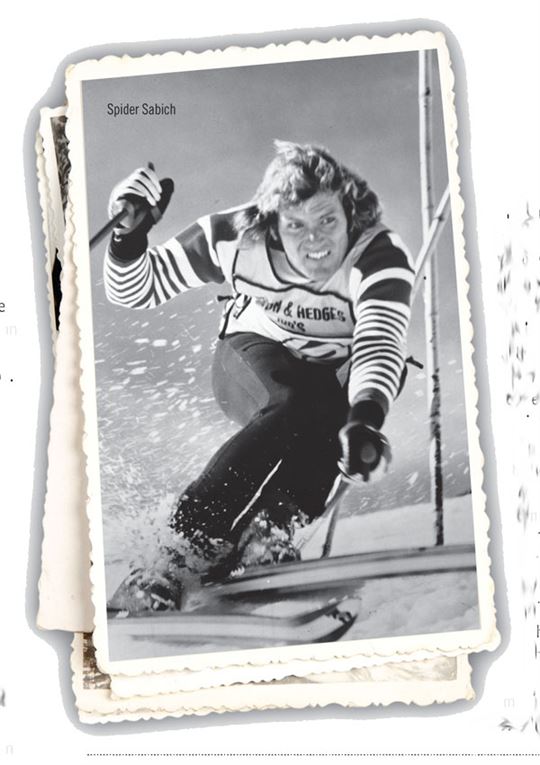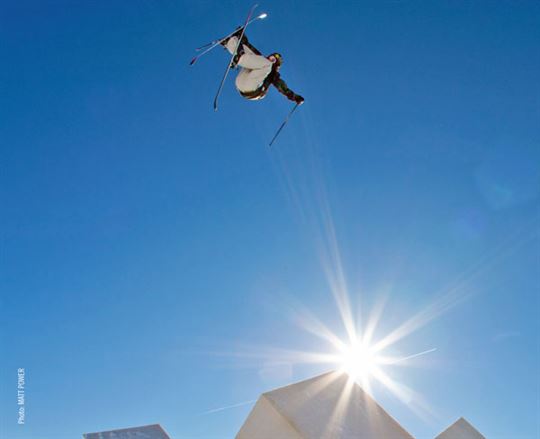by Kara Williams in December 2012 issue
From silver-mining boomtown to chic celeb hangout, Aspen’s illustrious history and infamous past have shaped the town into the legendary resort it is today.
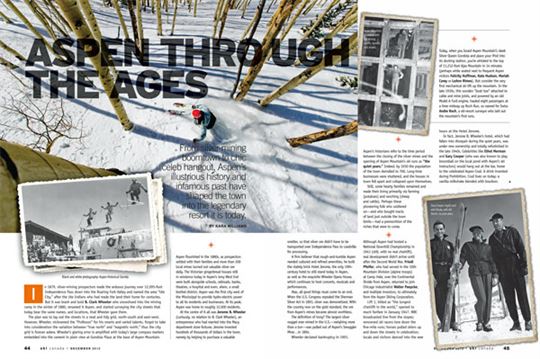
In 1879, silver-mining prospectors made the arduous journey over 12,095-foot Independence Pass down into the Roaring Fork Valley and named the area “Ute City,” after the Ute Indians who had made the land their home for centuries. But it was brash and bold B. Clark Wheeler who snowshoed into the mining camp in the winter of 1880, renamed it Aspen, and started surveying the city streets that today bear the same names, and locations, that Wheeler gave them.
The plan was to lay out the streets in a neat and tidy grid, north-south and east-west. However, Wheeler, nicknamed the “Professor” for his smarts and varied talents, forgot to take into consideration the variation between “true north” and “magnetic north,” thus the city grid is forever askew. Wheeler’s glaring error is amplified with today’s large compass markers embedded into the cement in plain view at Gondola Plaza at the base of Aspen Mountain.
*****************************************
Aspen flourished in the 1880s, as prospectors settled with their families and more than 200 local mines turned out valuable silver ore daily. The Victorian gingerbread houses still in existence today in Aspen’s tony West End were built alongside schools, railroads, banks, theatres, a hospital and even, ahem, a small brothel district. Aspen was the first city west of the Mississippi to provide hydro-electric power to all its residents and businesses. At its peak, Aspen was home to roughly 12,000 residents.
At the centre of it all was Jerome B. Wheeler (curiously, no relation to B. Clark Wheeler), an entrepreneur who had married into the Macy department store fortune. Jerome invested hundreds of thousands of dollars in the town, namely by helping to purchase a valuable smelter, so that silver ore didn’t have to be transported over Independence Pass to Leadville for processing.
A firm believer that rough-and-tumble Aspen needed cultured and refined amenities, he built the stately brick Hotel Jerome, the only 19th-century hotel to still stand today in Aspen, as well as the exquisite Wheeler Opera House, which continues to host concerts, musicals and performances.
Alas, all good things must come to an end. When the U.S. Congress repealed the Sherman Silver Act in 1893, silver was demonetized. With the country now on the gold standard, the ore from Aspen’s mines became almost worthless.
The definition of irony? The largest silver nugget ever mined in the U.S.—weighing more than a ton—was pulled out of Aspen’s Smuggler Mine…in 1894.
Wheeler declared bankruptcy in 1901.
*****************************************************
Aspen’s historians refer to the time period between the closing of the silver mines and the opening of Aspen Mountain’s ski runs as “the quiet years.” Indeed, by 1930 the population of the town dwindled to 700. Long-time businesses were shuttered, and the houses in town fell apart and collapsed upon themselves.
Still, some hearty families remained and made their living primarily via farming (potatoes) and ranching (sheep and cattle). Perhaps these pioneering folk who soldiered on—and who bought tracts of land just outside the town limits—had a premonition of the riches that were to come.
*****************************************************
Although Aspen had hosted a National Downhill Championship in 1941 (still, with no real chairlift), real development didn’t arrive until after the Second World War. Friedl Pfeifer, who
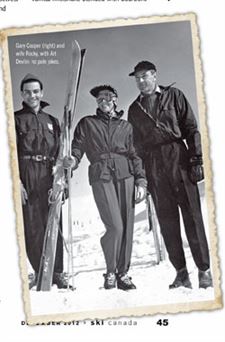
had served in the 10th Mountain Division (alpine troops) at Camp Hale, over the Continental Divide from Aspen, returned to join Chicago industrialist Walter Paepcke, and multiple investors, to ultimately form the Aspen Skiing Corporation.
Lift 1, billed as “the longest chairlift in the world,” opened to much fanfare in January 1947. NBC broadcasted live from the slopes; renowned ski racers tore down the five-mile runs; horses pulled skiers up and down the streets in celebration; locals and visitors danced into the wee hours at the Hotel Jerome.
In fact, Jerome B. Wheeler’s hotel, which had fallen into disrepair during the quiet years, was under new ownership and totally refurbished in the late 1940s. Celebrities like Ethel Merman and Gary Cooper (who was also known to play broomball on the local pond with Aspen’s ski instructors) would hang out at the bar, home to the celebrated Aspen Crud. A drink invented during Prohibition, Crud lives on today: a vanilla milkshake blended with bourbon.
******************************************************
Just as Aspen’s ski scene and party-hearty reputation started heating up, deep-pocketed Chicago businessman Walter Paepcke and his elegant wife, Elizabeth, introduced “The Aspen Idea,” a balance of “Mind, Body & Spirit,” where the increasingly noticed Colorado mountain town would be home, not only to stellar slopes, but rich cultural opportunities, too.
To kick things off was the Goethe Bicentennial in July 1949, a celebration of the German poet’s birth—in Aspen, so some of the world’s greatest minds could gather and share intellectual discourse amid inspiring mountain landscapes. Three days of music, headlined by the Minneapolis Symphony Orchestra, accompanied talks by philosophers such as Spain’s José Ortega y Gasset and American playwright Thornton Wilder.
The Bicentennial’s most distinguished guest was musician, intellectual and medical missionary Dr. Albert Schweitzer of Germany. Alas, the story goes that no one told the humanitarian—on his first and only visit to the U.S.—exactly where the festivities were to take place. He assumed that because all the correspondence surrounding his visit came from Paepcke’s Chicago address, that Aspen was somewhere in the vicinity. Thus, he was quite surprised to board a train for the 1,600-km journey to the mountains!
Still, the Goethe Bicentennial went off with nary a hitch, and its “exchange of ideas” in such an idyllic location lay the groundwork for the future Aspen Institute, International Design Conference and Aspen Music Festival & School. Other modern-day key institutions that add to Aspen’s “Mind, Body & Spirit” culture: Aspen Santa Fe Ballet, Aspen Art Museum, Anderson Ranch Arts Center and Theatre Aspen, to name just a few.
********************************************************
Aspen’s most entertaining and endearing resident in the 1950s? Hands down, that’s Freddie Fisher, who operated a Main Street fix-it shop. He’d troll the local dump for broken items and make them as good as new. But Freddie was also a musician, and a talented one at that, playing Dixieland music on his clarinet with his Schnickelfritz Band in the late 1930s and ’40s. He even had a contract with Warner Bros., was featured in more than a dozen movies and short films, and made a couple of hundred records over the years.
But to Aspenites, he was simply “Freddie the Fixer,” who also invented a process for electroplating Aspen leaves as jewelry and who frequently philosophized with pithy prose in his plentiful letters to the editor of The Aspen Times.
Freddie represented the melting pot of people who descended upon Aspen in the 1950s to reinvent themselves. Aspen was a place where your ski instructor could have been a medical doctor…or your waitress a former Broadway chorus girl.
*******************************************************
The 1960s brought an influx of transplants. Recent college grads (or dropouts) hightailed it to Aspen to initiate the ski bum culture that remains today: bunk with a bunch of roommates in a tiny apartment (or back then, a rooming house) and take only menial jobs (waiting tables, cleaning hotel rooms, loading ski lifts) that allow plenty of time on the slopes and plenty of time to party.
Stewart Kinkade arrived in Aspen in 1961. He put his experiences to verse in a paperback, Aspen Bummin’. Here’s an excerpt from “Finding Work”:
The work was daily, days off none,
We quit at noon, the rooms all done
With time to ski. The evenings long
I drank in friendship, beer and song.
*******************************************************
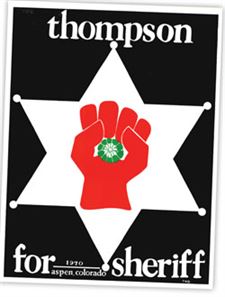 With a campaign platform to legalize marijuana, gonzo journalist Hunter S. Thompson ran for Pitkin County sheriff in 1970. His opponent was a reactionary incumbent who led the crackdown on pot-smoking hippies and other vagrants in Aspen. On his “Freak Power Ticket” (whose campaign poster featured a two-thumbed fist clutching a peyote button), Thompson also promised to fire all of the county’s conservative officials and rename the town “Fat City.”
With a campaign platform to legalize marijuana, gonzo journalist Hunter S. Thompson ran for Pitkin County sheriff in 1970. His opponent was a reactionary incumbent who led the crackdown on pot-smoking hippies and other vagrants in Aspen. On his “Freak Power Ticket” (whose campaign poster featured a two-thumbed fist clutching a peyote button), Thompson also promised to fire all of the county’s conservative officials and rename the town “Fat City.”
He lost.
*******************************************************
Although John Denver always said his song “Rocky Mountain High” characterized the natural elation he felt amid Aspen’s mountains, the tune could also describe Aspen’s freewheeling culture from the 1970s into the ’80s, when cocaine became the drug of choice among Aspen’s party crowd.
The scene turned deadly in 1985 when Steven Grabow was killed when his borrowed Jeep blew up as he stepped in the parking lot of the Aspen Club. From a report in Aspen Sojourner magazine: “The 38-year-old, who had no visible means of support, was facing a federal trial as the alleged kingpin of a cocaine ring valued at up to $35 million a year. Among the items seized from his home were a Porsche, $1.5 million in cash and 243 gold Krugerrand coins. Some have even speculated that the crime, which remains unsolved, leads back to Colombia’s Medellín cartel.”
*********************************************************
Psychopath Ted Bundy abducted, sexually assaulted and killed at least 30 women in the 1970s, including Caryn Campbell of Snowmass Village (10 miles from Aspen). When he was standing trial for Campbell’s death in June 1977, Bundy was, peculiarly, left unattended without leg irons or handcuffs in Aspen’s Pitkin County Courthouse. He jumped out of a second-floor window and ran into the surrounding mountains.
For six days, petrified Aspen residents (atypically) locked their doors while Bundy remained on the loose. Eventually, a hungry, sleep-deprived Bundy descended into town, where local police apprehended him.
A short six months later Bundy escaped once more—this time from the county jail in Glenwood Springs, an hour’s drive west of Aspen. And this time, he avoided capture long enough to make his way to Florida, attacking and killing young women there.
************************************************************
Certainly Aspen’s reputation as an upscale hangout for the wealthy was cemented in the late 1980s and ’90s, when stores like Prada, Chanel and Gucci cropped up in town; the Ritz-Carlton (now the St. Regis) opened; private jets lined up wing-to-wing at Aspen’s airport on holiday weekends; and fur was the long-coat coverage of choice for discerning visitors (a campaign to ban fur within town limits failed in 1990).
Movie stars continued to flock to the slopes and party at venues like the private Caribou Club. Steve Martin, Jack Nicholson, George Hamilton and Sally Field are just a few of the Hollywood elite who sought refuge from boisterous fans in the tiny mountain town, where they were often met with indifference by locals. Musicians Don Henley, Jimmy Buffett and John Oates liked the town so much after a few visits that they each bought property in Aspen.
*****************************************************
Today, when you board Aspen Mountain’s sleek Silver Queen Gondola and place your iPod into its docking station, you’re whisked to the top of 11,212-foot Ajax Mountain in 14 minutes (perhaps while seated next to frequent Aspen visitors Felicity Huffman, Kate Hudson, Mariah Carey or LeAnn Rimes). But consider the very first mechanical ski lift up the mountain. In the late 1930s, this wooden “boat tow” attached to cable and mine joists, and powered by an old Model A Ford engine, hauled eight passengers at a time midway up Roch Run, so named for Swiss Andre Roch, a ski-resort surveyor who laid out the mountain’s first runs.
*****************************************************
A major scandal rocked Aspen and made headlines around the world in 1976. Olympic and World Cup alpine ski racer Vladimir “Spider” Sabich was shot in his Starwood home by his live-in girlfriend, French singer-actress Claudine Longet, who had just divorced crooner and father of their three children Andy Williams. Longet claimed the gun accidentally went off when Sabich was showing her how to use it; friends told People that the relationship had soured and was at times “turbulent.”
Botched gathering and handling of the evidence by investigators led to Longet only being convicted of misdemeanour negligence homicide. She served 30 days in jail—and then started dating her defence lawyer, Ron Austin—who was married at the time. Today, Longet and Austin are wed and still living in Aspen.
*************************************************************
Today, Aspen continues to make headlines, with its long-time quirky characters and heralded events. There’s local Pat Milligan, otherwise known as the “sandwich board lady,” who has walked around town for 34 years wearing a two-sided sign advertising local businesses. And Jon Barnes, who runs the blinged-out Ultimate Taxi, “The Only Recording Studio, Theater, Nightclub, Planetarium, Toy Store, Internet Connected Taxi In The World.”
Every January, Aspen’s Buttermilk Mountain takes centre stage during the televised ESPN Winter X Games, where Shaun White wows the crowds with his flying McTwist in the superpipe.
And yes, celebrities continue to play and party in town—some behaving quite badly. Charlie Sheen was arrested for felony domestic violence in 2009; two years later Sheen’s ex-wife, Brooke Mueller, was booked for cocaine possession.
- Every January, Aspen’s Buttermilk Mountain takes centre stage during the televised ESPN Winter X Games, where Shaun White wows the crowds with his flying McTwist in the superpipe. photo: MATT POWER
u
Aspen’s Power of Four
With one lift ticket, you can ski four different Aspen/Snowmass mountains, all within 10 miles of one another and all connected via free ski shuttles.
ASPEN MOUNTAIN
• The original ski area, dating back to 1947.
• No green trails mean few, if any, beginner skiers on the mountain.
• To locals, it’s “Ajax.”
• Take a powder tour on the backside of the mountain: “Fresh tracks guaranteed.”
• 76 trails on 273 hectares.
SNOWMASS
• Opened in 1967.
• Known for its varied terrain and kid-friendly Treehouse Adventure Center.
• Replacing the on-mountain Café Suzanne is the brand-new Restaurant at Elk Camp, serving rotisserie chicken, fresh pastas, hearty soups and homemade pizzas.
• Longest run is 8.5 km.
• 91 trails on 1,267 hectares.
BUTTERMILK
• Home of the ESPN Winter X Games.
• Terrain parks include more than 100 features and a 7-metre superpipe.
• Went through an identity crisis in the 1990s, when it briefly became known as Buttermilk/Tiehack, then simply Tiehack. (“Buttermilk” sounded too wimpy, thought Aspen Ski Company execs.) Today, it’s Buttermilk again; Tiehack refers to the easternmost base area and runs.
• 44 trails on 190 hectares.
ASPEN HIGHLANDS
• Long known as the “locals’ mountain,” it was independently owned (not part of the Aspen Skiing Company) until 1993.
• It’s a literal hike to the top of 3,777-metre Highland Bowl, for stellar in-bound runs.
• Just call it “Highlands.”
• 118 trails on 1,416 hectares.
Plan some good days: www.aspensnowmass.com
See more on the old days: www.aspenhistory.org
